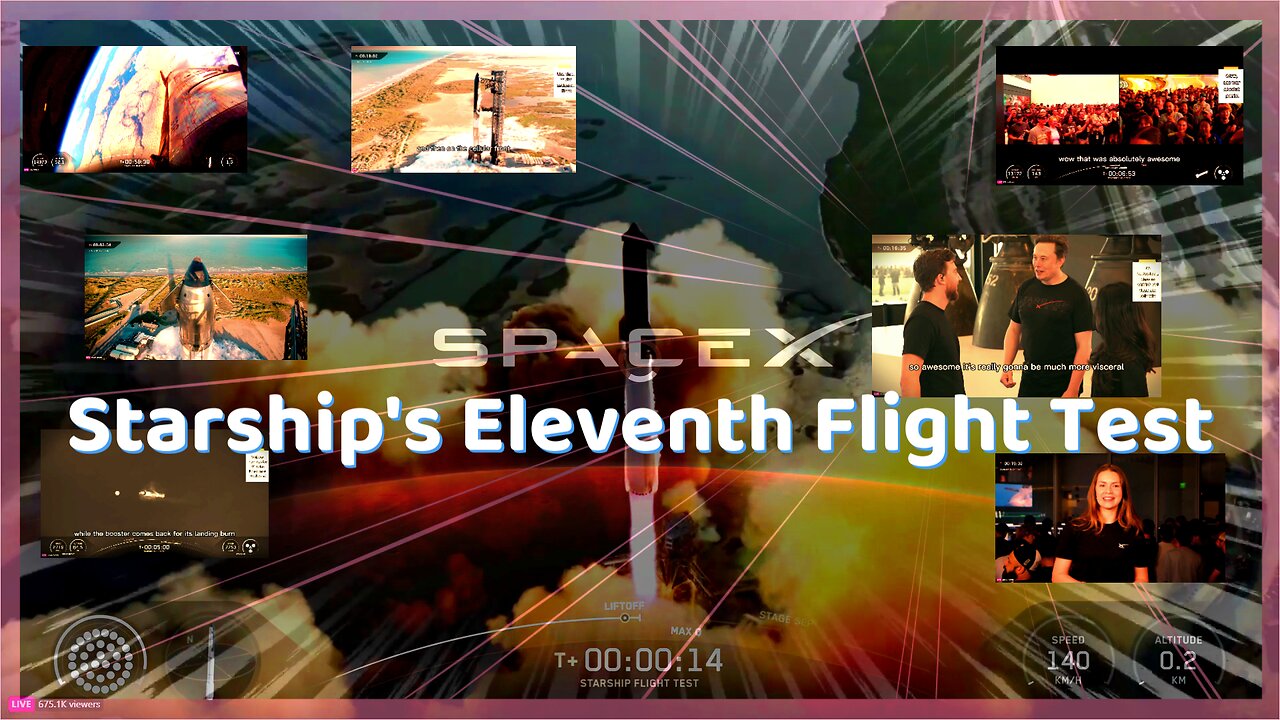Premium Only Content

October 13, 2025 Starship's Eleventh Flight Test . Abridged Version
October 13, 2025
Starship's Eleventh Flight Test
Abridged Version
On Monday, October 13, 2025, at 6:23 p.m. CT, Starship launched from Starbase in Texas for its eleventh flight test. This was the final flight of the second-generation Starship and the first-generation Super Heavy boosters, as well as the final launch from the current Pad 1 configuration. All major objectives of the flight test were met, providing valuable data for preparing for the next generation Starship and Super Heavy.
The flight test began with the ignition of all 33 of the Super Heavy's Raptor engines and the ascent over the Gulf. The successful first-stage ascent was followed by a hot-staging maneuver, during which Starship's upper stage fired its six Raptor engines to continue its flight into space.
Following stage separation, the Super Heavy booster completed its boostback burst and set a course for a planned splashdown zone off the Texas coast, utilizing 12 of its 13 designated engines. At the same angle of attack tested during the previous flight, the booster descended until all 13 designated engines (including one that was not re-ignited during the boostback burst) were successfully fired for the high-thrust portion of the landing burst. The booster successfully executed a unique landing burst intended for use in next-generation boosters. Super Heavy hovered over the water before shutting down its engines and ditching.
After completing a full ascent burst, Starship reached its planned speed and trajectory. During the flight, Starship successfully deployed eight Starlink simulators and conducted the third re-ignition of a Raptor engine in space, demonstrating a critical capability for future deorbit bursts.
Starship re-entered Earth's atmosphere and was able to collect extensive data on the performance of its heat shield, which was subjected to targeted loading to explore the vehicle's capabilities. In the final minutes of flight, Starship performed a dynamic banked maneuver to replicate the trajectory of future missions to the Starbase. Starship then used its four flaps to steer to the planned splashdown zone in the Indian Ocean and successfully completed a rollover, burn, and soft splashdown.
The focus now turns to the next generation of Starship and Super Heavy. Several vehicles are currently under construction and being prepared for testing. This next iteration will be used for Starship's first orbital flights, operational payload missions, propellant transfers, and much more as we progress toward a fully and rapidly reusable vehicle capable of operating in Earth orbit, on the Moon, Mars, and beyond.
Countdown (Original)
All times are approximate.
Hr/Min/Sec Event
01:15:00 SpaceX Flight Director conducts survey and confirms launch clearance for propellant
00:53:00 Loading ship fuel (liquid methane)
00:46:10 Loading ship LOX (liquid oxygen)
00:41:15 Loading booster fuel
00:35:52 Loading booster LOX
00:19:40 Raptor begins booster and ship engine cooldown
00:03:20 Loading ship fuel
00:02:50 Loading booster fuel
00:00:30 SpaceX Flight Director confirms launch clearance
00:00:10 Flame deflector activation
00:00:03 Raptor ignition sequence begins
00:00:00 Voltage guaranteed
FLIGHT TEST TIMETABLE (Original)
All times are approximate
hr/min/sec Event
00:00:02 Launch
00:01:02 Max Q (moment of maximum aerodynamic loading of the rocket)
00:02:37 Super Heavy MECO (most engines shut down)
00:02:39 Hot Stage Formation (Starship Raptor ignition and stage separation)
00:02:49 Super Heavy Boostback Burn Start
00:03:38 Super Heavy Boostback Burn Shutdown
00:03:40 Hot Stage Jettison
00:06:20 Super Heavy Landing Burn Start
00:06:36 Super Heavy Landing Burn Shutdown
00:08:58 Starship Engine Shutdown
00:18:28 Payload Demo Launch
00:25:33 Payload Demo Complete
00:37:49 Raptor reignition in space
00:47:43 Starship entry
01:03:30 Starship is transonic
01:03:52 Starship is subsonic
01:05:58 Landing start
01:06:00 Landing turn
01:06:09 Landing with 3 to 2 engines
01:06:25
Why Starlink simulators and not real satellites? Test focus instead of operational payload: This flight was a test flight (Flight 11) whose primary goal was to validate Starship's functionality (e.g., heat shield, Raptor reignition in space, landing maneuver), not a commercial mission. Simulators allow for payload deployment testing without the risk of launching expensive, operational satellites. to lose if something goes wrong.
Real Starlink satellites are expensive (approximately $250,000–$500,000 per satellite, based on estimates) and optimized for operation in low Earth orbit (LEO). A test flight with experimental maneuvers (e.g., intentionally loading the heat shield) carries a higher risk, and SpaceX didn't want to jeopardize valuable hardware.
Simulators are simpler and more flexible: Starlink simulators are essentially "dummy" weights that mimic the mass, size, and behavior of real satellites but don't contain complex electronics or communications systems. They are cheaper and faster to manufacture, which is ideal for test flights.
They allowed SpaceX to test the ejection mechanism (approximately 18:28–25:33 into flight) without the complexity of real satellites, which would require, for example, precise orbital alignment or communications tests.
Trajectory and mission not orbital: The flight test reached space, but was suborbital, with a landing in the Indian Ocean. Real Starlink satellites require precise orbital insertion (e.g., 550 km altitude) to function. The trajectory of this test was not designed to place satellites into a stable orbit, but rather to collect data for reentry and landing.
A real Starlink would therefore have been of no use, as it would not have been deployed in an operational orbit.
Iterative development: SpaceX uses such test flights to validate functions step by step. The successful deployment of the simulators (approximately eight units) was a milestone in confirming the payload mechanism for future orbital flights. Real Starlinks will arrive once Starship is certified for orbital missions (expected with the next generation, in 2026).
Why does this make sense? Risk management: A failure (e.g., during re-entry or landing) would have destroyed real satellites, causing unnecessary costs and public relations problems.
Data priority: The data obtained (e.g., on the ejection mechanism and Raptor reignition) is more valuable than deploying real satellites in a test context.
Sustainability: Simulators minimize material waste because they are simpler and no valuable resources are lost (as with real satellites).
Conclusion: SpaceX could theoretically have deployed real Starlink satellites, but it would have been inefficient and risky, as the flight was not designed to reach an operational orbit. The simulators were a pragmatic choice to test the technology and collect data while SpaceX prepares for orbital flights with the next generation of Starship.
sources:
#spacex.com/launches/starship-flight-11
#x.com/i/grok?conversation
-
 16:30
16:30
GritsGG
2 days agoWarzone's New Zombie Royal Mode is AWESOME!
5.73K1 -
 1:43:07
1:43:07
The Michelle Moore Show
3 days ago'The 12 Open Doors' Guest, Steve Jarvis: The Michelle Moore Show (Oct 17, 2025)
39.7K14 -
 30:55
30:55
TruthStream with Joe and Scott
7 days agoTruthStream in Ireland, Rebels Across the Pond, Bono discussed, with Freedom Now Acoustic from a Pub
9.74K9 -
 3:12:34
3:12:34
Badlands Media
1 day agoThe Narrative Ep. 43: Unity.
351K80 -
 2:43:11
2:43:11
TheSaltyCracker
11 hours agoWe Kill You Rally ReeEEStream 10-19-25
104K288 -
 7:54:17
7:54:17
Putther
16 hours ago $29.61 earned🔴LAZY SUNDAY STREAM!! (GTA + MORE)
82.3K9 -
 10:38
10:38
Colion Noir
10 hours agoHe Installed a Forced Reset Trigger at a Gun Range… and Got Arrested | What You Need to Know
61.9K23 -
 1:29:26
1:29:26
HELMETFIRE
9 hours ago🟢GAMING WITH FIRE EP13🟢
33.9K4 -
 50:40
50:40
Sarah Westall
11 hours agoAI, Social Media & Brain Atrophy: Destroying Human Capacity to Think w/ Rob Smith
38.4K12 -
 2:32:08
2:32:08
THOUGHTCAST With Jeff D.
8 hours ago $21.91 earnedSunday Night FORTNITE with THOUGHTCAST Jeff D & crew.
41.4K5